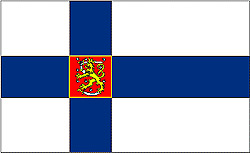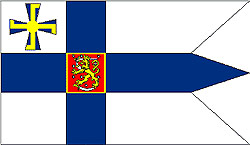The President of the Republic of Finland: Position and Duties: Flag
Flag
History
 State flag
State flagThe flag of Finland was introduced in the mid-19th century with the intention of making Finnish vessels more distinct from Russian ones. Finnish merchant ships had come under attack from Russia's enemies and it was thought that future incidents of this kind could be avoided by sailing under a separate ensign.
In 1861 Czar Alexander II gave Nylandska Jaktklubben (The Nyland Yacht Club) his assent to adopt a set of rules which allowed the vessels of club members to sail under "a white flag with an upright blue cross" and the complete coat of arms of the Province of Nyland in the upper corner. The following year, similar flags with the relevant coats of arms of their respective localities were decreed for other yacht clubs. This prompted a proposal in the Diet in 1863 that a flag for the Grand Duchy as a whole be adopted. However, the matter was never deliberated and lapsed. Nevertheless, the issue of a flag continued to germinate in the minds of citizens and numerous proposals concerning a "Finnish flag" appeared in the press.
During the so-called Period of Oppression between 1899 and 1917, when Finland was subjected to an intense campaign of Russification, the issue arose again and resulted in the "Lion Flag" based on the coat of arms. Two different colour combinations were proposed in the discourse on the flag: red/yellow and blue/white. The motif most commonly proposed was a cross.
Finland gained national independence in late 1917 and, naturally, needed an official flag. Since a consensus on what it should look like failed to emerge, the "Lion Flag" was provisionally adopted.
The issue came up yet again after the Civil War in 1918 and a white flag with a horizontal blue cross was adopted. The design was similar to that of the other Nordic flags, but its colours made it sufficiently distinct.
Current flag
 Flag of the President of the Republic
Flag of the President of the RepublicThe official standard is stipulated in current legislation as Finland's first flag. It has a blue cross on a white field, with the coat of arms in the centre. Other flags are derived from it. They include the basic flag without the coat of arms, the military banner with the coat of arms and three points, and the presidential standard, which has three points, the coat of arms and the Cross of Freedom in its upper corner.
More information is available on the website of the Ministry of Interior.
About this site webmaster[at]tpk.fi



